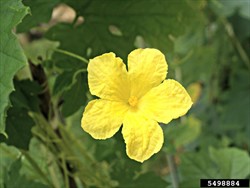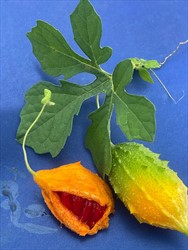- Worldwide distribution. In Australia and most Pacific island countries. Aggressive, fast-growing vine of tropical and subtropical regions, tolerant of different soil types and rainfall, rapidly flowering. Often an escape from cultivation. Common on fences, walls, along creeks and rivers, coastal areas, waste ground, edges of rainforests, as well as many horticultural, orchard and plantation crops.
- Impact not well reported. In Queensland, smothers sugarcane; PNG a problem weed of pastures - unpalatable. Fruits a host of melon fly.
- Slender, hairy vines, slightly ridged, sprawling to 2.3 m. Leaves, alternate, separated into 5-7 lobes, irregular toothed margins. Flowers yellow, sexes separate on same plant. with five petals. Fruit ridged, warty, green then orange-yellow, splitting into three. Seeds with edible flesh, black and numerous.
- Spread: seeds by birds and other animals; underground stems; stem pieces by machinery. Long distance sale of seeds.
- Biosecurity: very high risk; threat to native plants and crops. Seed readily available on Internet.
- Biocontrol: none.
- Cultural control: hand-pulling; collect stem pieces and burn. Cut at soil level, repeating as roots regrow from taproot.
- Chemical control: In Australia, fluroxypyr in sugarcane; 2,4-D and fluroxypyr in non-agricultural areas. In FSM, triclopyr and glyphosate.









